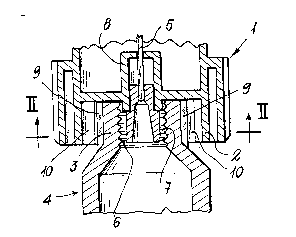Some of the information on this Web page has been provided by external sources. The Government of Canada is not responsible for the accuracy, reliability or currency of the information supplied by external sources. Users wishing to rely upon this information should consult directly with the source of the information. Content provided by external sources is not subject to official languages, privacy and accessibility requirements.
Any discrepancies in the text and image of the Claims and Abstract are due to differing posting times. Text of the Claims and Abstract are posted:
| (12) Patent: | (11) CA 1284792 |
|---|---|
| (21) Application Number: | 1284792 |
| (54) English Title: | DEVICE FOR FIRMLY LOCKING A SYRINGE ON A BODY WHICH MAY BE COUPLED THERETO |
| (54) French Title: | DISPOSITIF POUR VERROUILLER SOLIDEMENT UNE SERINGUE SUR UN OBJET |
| Status: | Expired and beyond the Period of Reversal |
| (51) International Patent Classification (IPC): |
|
|---|---|
| (72) Inventors : |
|
| (73) Owners : |
|
| (71) Applicants : |
|
| (74) Agent: | SMART & BIGGAR LP |
| (74) Associate agent: | |
| (45) Issued: | 1991-06-11 |
| (22) Filed Date: | 1987-07-22 |
| Availability of licence: | N/A |
| Dedicated to the Public: | N/A |
| (25) Language of filing: | English |
| Patent Cooperation Treaty (PCT): | No |
|---|
| (30) Application Priority Data: | ||||||
|---|---|---|---|---|---|---|
|
26533-6
ABSTRACT
A device is disclosed which comprises a body provided with
members for coupling it to one end of a bottle or the like and has
a seat for housing the free end of a syringe, with a hole for
allowing for the syringe needle to pass therethrough. The device
further comprises a syringe the free end of which may be housed
and threaded in said seat. On the side opposite surfaces of the
body seat and at the syringe end provided for insertion in the
seat, there are formed radially projecting longitudinal teeth and
respectively slanted resilient fins which are deflected by the
teeth as the syringe is threaded to the body and which abut against
the fins for preventing the syringe from being screwed off the
body.
Note: Claims are shown in the official language in which they were submitted.
Note: Descriptions are shown in the official language in which they were submitted.

2024-08-01:As part of the Next Generation Patents (NGP) transition, the Canadian Patents Database (CPD) now contains a more detailed Event History, which replicates the Event Log of our new back-office solution.
Please note that "Inactive:" events refers to events no longer in use in our new back-office solution.
For a clearer understanding of the status of the application/patent presented on this page, the site Disclaimer , as well as the definitions for Patent , Event History , Maintenance Fee and Payment History should be consulted.
| Description | Date |
|---|---|
| Inactive: IPC expired | 2023-01-01 |
| Inactive: IPC from MCD | 2006-03-11 |
| Inactive: Adhoc Request Documented | 1994-06-11 |
| Time Limit for Reversal Expired | 1993-12-13 |
| Letter Sent | 1993-06-11 |
| Grant by Issuance | 1991-06-11 |
There is no abandonment history.
Note: Records showing the ownership history in alphabetical order.
| Current Owners on Record |
|---|
| FARMITALIA CARLO ERBA S.R.L. |
| Past Owners on Record |
|---|
| LUIGI VALENTINI |
| MARIO COCCIA |